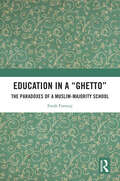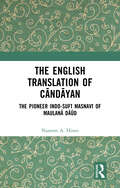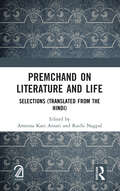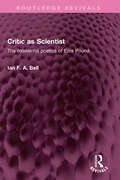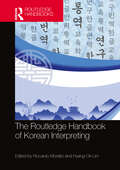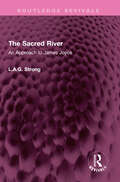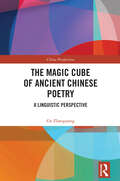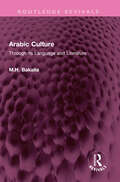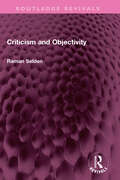- Table View
- List View
Contagion, Hygiene, and the European Avant-Garde (Routledge Research in Art History)
by David Hopkins Disa PerssonThis interdisciplinary collection of essays brings together scholars in the fields of art history, theatre, visual culture, and literature to explore intersections between the European avant-garde (c. 1880–1945) and themes of health and hygiene, such as illness, contagion, cleanliness, and contamination. Examining the artistic oeuvres of some of the canonical names of modern art – including Edgar Degas, Edvard Munch, Pablo Picasso, George Orwell, Marcel Duchamp, and Antonin Artaud – this book investigates instances where the heightened political, social, and cultural currencies embedded within issues of hygiene and contagion have been mobilised, and subversively exploited, to fuel the critical strategy at play. This edited volume promotes an interdisciplinary and socio-historically contextualised understanding of the criticality of the avant-garde gesture and cultivates scholarship that moves beyond the limits of traditional academic subjects to produce innovative and thought-provoking connections and interrelations across various fields. The book will be of interest to scholars working in art history, literature, theatre, cultural studies, modern history, medical humanities, and visual culture.
Contagion, Hygiene, and the European Avant-Garde (Routledge Research in Art History)
by David Hopkins Disa PerssonThis interdisciplinary collection of essays brings together scholars in the fields of art history, theatre, visual culture, and literature to explore intersections between the European avant-garde (c. 1880–1945) and themes of health and hygiene, such as illness, contagion, cleanliness, and contamination. Examining the artistic oeuvres of some of the canonical names of modern art – including Edgar Degas, Edvard Munch, Pablo Picasso, George Orwell, Marcel Duchamp, and Antonin Artaud – this book investigates instances where the heightened political, social, and cultural currencies embedded within issues of hygiene and contagion have been mobilised, and subversively exploited, to fuel the critical strategy at play. This edited volume promotes an interdisciplinary and socio-historically contextualised understanding of the criticality of the avant-garde gesture and cultivates scholarship that moves beyond the limits of traditional academic subjects to produce innovative and thought-provoking connections and interrelations across various fields. The book will be of interest to scholars working in art history, literature, theatre, cultural studies, modern history, medical humanities, and visual culture.
Education in a 'Ghetto': The Paradoxes of a Muslim-Majority School
by Farah FarooqiThis book explores the structures of power and politics within a government-aided school situated in a Muslim-majority area in Delhi, India. It provides a look into how teachers, administrators and students in low-income and disadvantaged communities navigate limited opportunities and resources. The book discusses the socio-economic and cultural background of students, institutional rituals and practices and the impact of power relations on the students. It critiques the power and privilege of those in positions of authority in the school and showcases how bureaucratic systems in state run schools often do not consider the circumstances and interests of students and often hinder their growth. This book will be of interest to students of education, sociology, development studies, political science and social work. It will also be useful to educationalists, sociologists, political scientists, NGOs and those interested in the interface of state, society and education.
Education in a 'Ghetto': The Paradoxes of a Muslim-Majority School
by Farah FarooqiThis book explores the structures of power and politics within a government-aided school situated in a Muslim-majority area in Delhi, India. It provides a look into how teachers, administrators and students in low-income and disadvantaged communities navigate limited opportunities and resources. The book discusses the socio-economic and cultural background of students, institutional rituals and practices and the impact of power relations on the students. It critiques the power and privilege of those in positions of authority in the school and showcases how bureaucratic systems in state run schools often do not consider the circumstances and interests of students and often hinder their growth. This book will be of interest to students of education, sociology, development studies, political science and social work. It will also be useful to educationalists, sociologists, political scientists, NGOs and those interested in the interface of state, society and education.
The English Translation of Cāndāyan: The Pioneer Indo-Sufī Masnavī of Maulanā Dāūd
by Naseem A. HinesThis book is the first English translation of Cāndāyan, the pioneer work in a long tradition of Indian-Sufi love narratives. The story was adapted from an oral epic Chanaini, popular in the Awadhi speaking region of north India in the fourteenth century. The early manuscripts of Cāndāyan, though composed in the Awadhi dialect, were recorded in the Persian script. Each stanza-like unit is introduced by a phrase or sentences in the Persian language style, making it necessary for a reader to know the Persian script and language, as well as the Awadhi dialect. This somewhat limits the access to fully explore Cāndāyan. In addition to this, the esoteric interpretation, which is the distinguishing feature that gives the Indian-Sufi masnavī literature its unique identity, was also not yet realized. Cāndāyan deserves to be celebrated and recognized because it marks the beginning of the indigenizing process of the masnavī in India, and served as a model for this literary genre for the next 540 years. A serious study of Maulana Daud’s Cāndāyan, composed in 1379, in the reign of Firoz Shah Tughlaq, did not begin until well into the twentieth century because only a few pages of its manuscript folios were discovered at a time, in various academic institutions and museums around the world. Cāndāyan is a fascinating study of the blending of the features of the Persian masnavī with the features of the Hindi premākhyān narratives and the features of the medieval Jain literature. Even today, annually in the Mahakoshala region Cāndāyan is presented in the form of drama and in the folk-song and play forms. Print edition not for sale in South Asia (India, Sri Lanka, Nepal, Bangladesh, Pakistan and Bhutan)
The English Translation of Cāndāyan: The Pioneer Indo-Sufī Masnavī of Maulanā Dāūd
by Naseem A. HinesThis book is the first English translation of Cāndāyan, the pioneer work in a long tradition of Indian-Sufi love narratives. The story was adapted from an oral epic Chanaini, popular in the Awadhi speaking region of north India in the fourteenth century. The early manuscripts of Cāndāyan, though composed in the Awadhi dialect, were recorded in the Persian script. Each stanza-like unit is introduced by a phrase or sentences in the Persian language style, making it necessary for a reader to know the Persian script and language, as well as the Awadhi dialect. This somewhat limits the access to fully explore Cāndāyan. In addition to this, the esoteric interpretation, which is the distinguishing feature that gives the Indian-Sufi masnavī literature its unique identity, was also not yet realized. Cāndāyan deserves to be celebrated and recognized because it marks the beginning of the indigenizing process of the masnavī in India, and served as a model for this literary genre for the next 540 years. A serious study of Maulana Daud’s Cāndāyan, composed in 1379, in the reign of Firoz Shah Tughlaq, did not begin until well into the twentieth century because only a few pages of its manuscript folios were discovered at a time, in various academic institutions and museums around the world. Cāndāyan is a fascinating study of the blending of the features of the Persian masnavī with the features of the Hindi premākhyān narratives and the features of the medieval Jain literature. Even today, annually in the Mahakoshala region Cāndāyan is presented in the form of drama and in the folk-song and play forms. Print edition not for sale in South Asia (India, Sri Lanka, Nepal, Bangladesh, Pakistan and Bhutan)
Environmental Humanities in Folktales: Theory and Practice
by P. Mary PorselviThis work throws light on the areas of space and time, nature and culture, spirit and matter in the folktales that nurture systemic thinking. It identifies and explores motifs and patterns in select folktales that promote interconnectedness, interdependence, holism, synthesis, and circular pattern of life and examines the ecological relevance of folktales in fostering a systematic view of life. The volume discusses why it is important to critically analyze alternative worldviews in order to find holistic solutions to contemporary global ecological issues. It sheds light upon Ecofemiotics as a discipline, a portmanteau of Ecofeminist Semiotics, and through a re-reading of folktales, it puts forward an innovative folktale typology which connects women with environment. The book discusses an ecofemiotics cyclical praxis at three levels, • Promoting theory to practice through the analysis of folktales as Gaia Care Narratives using the Ecofemiotic framework. • Enabling practice to theory, through a classroom experiment, observation, and inference. • Envisioning theory to practice, through the identification of Gaia Care Principles and its multidisciplinary hands-on scope and function to create avenues towards ecological balance and sustainable living. Inspired by the hearts that tell stories of love, care, nurture, and the Earth, this nuanced work will be of interest to students and researchers of literature and literary theory, sociology, social anthropology, gender studies and women’s studies, feminism, development studies, environment, and folklore studies.
Environmental Humanities in Folktales: Theory and Practice
by P. Mary PorselviThis work throws light on the areas of space and time, nature and culture, spirit and matter in the folktales that nurture systemic thinking. It identifies and explores motifs and patterns in select folktales that promote interconnectedness, interdependence, holism, synthesis, and circular pattern of life and examines the ecological relevance of folktales in fostering a systematic view of life. The volume discusses why it is important to critically analyze alternative worldviews in order to find holistic solutions to contemporary global ecological issues. It sheds light upon Ecofemiotics as a discipline, a portmanteau of Ecofeminist Semiotics, and through a re-reading of folktales, it puts forward an innovative folktale typology which connects women with environment. The book discusses an ecofemiotics cyclical praxis at three levels, • Promoting theory to practice through the analysis of folktales as Gaia Care Narratives using the Ecofemiotic framework. • Enabling practice to theory, through a classroom experiment, observation, and inference. • Envisioning theory to practice, through the identification of Gaia Care Principles and its multidisciplinary hands-on scope and function to create avenues towards ecological balance and sustainable living. Inspired by the hearts that tell stories of love, care, nurture, and the Earth, this nuanced work will be of interest to students and researchers of literature and literary theory, sociology, social anthropology, gender studies and women’s studies, feminism, development studies, environment, and folklore studies.
Premchand on Literature and Life: Selections (Translated from the Hindi)
Premchand on Literature and Life is a collection of Premchand's (1880-1936) fifty non-fiction prose pieces translated into English. The selected pieces in the collection compirse his editorials and articles which appeared in literary magazines and periodicals like Hans and Zamana, and cover a period from the early 1920s till 1936. In them, Premchand emerges as a literary critic and social commentator, holding forth on literature, his literary world, and the socio-cultural milieu of his ties. His keen observations and insightful critique are a call for evolving appropriate processes and agencies to encourage literary creativity and evaluation. In the selected prose pieces, Premchand’s views are like a prism through which a nation's literary quotient can be assessed. This book is co-published with Aakar Books. Print edition not for sale in South Asia (India, Sri Lanka, Nepal, Bangladesh, Pakistan and Bhutan)
Premchand on Literature and Life: Selections (Translated from the Hindi)
by Ameena Kazi Ansari Ruchi NagpalPremchand on Literature and Life is a collection of Premchand's (1880-1936) fifty non-fiction prose pieces translated into English. The selected pieces in the collection compirse his editorials and articles which appeared in literary magazines and periodicals like Hans and Zamana, and cover a period from the early 1920s till 1936. In them, Premchand emerges as a literary critic and social commentator, holding forth on literature, his literary world, and the socio-cultural milieu of his ties. His keen observations and insightful critique are a call for evolving appropriate processes and agencies to encourage literary creativity and evaluation. In the selected prose pieces, Premchand’s views are like a prism through which a nation's literary quotient can be assessed. This book is co-published with Aakar Books. Print edition not for sale in South Asia (India, Sri Lanka, Nepal, Bangladesh, Pakistan and Bhutan)
Critic as Scientist: The modernist poetics of Ezra Pound (Routledge Revivals)
by Ian F. BellFirst published in 1981, Critic as Scientist provides a detailed and scholarly account both of the scientific background and of contemporary artistic issues in its analysis of Ezra Pound’s poetics. During the crucial period of his years in London, Ezra Pound was striving to formulate not only a new system of poetics but also a new language through which he could both define the critic’s procedure and announce his modernity. It was in science that Pound discovered the vocabulary that became his most characteristic gesture during the literary crises of the time. The use of scientific terminology in his ‘propaganda’ for a new ‘renaissance’ belonged, initially, to specifically American modes of aesthetic tradition, as typified by Whistler and aspects of New England transcendentalism. A consideration of popular versions of physics and biology, and of the ‘scientific attitude’ displayed by such contemporaries as Fenollosa, Hulme, Ford and Eliot, reveals that the major terms and practices of Pound’s critical vocabulary were located in the issues of nineteenth and early twentieth-century science. The author has sought to demystify key words in the Poundian vocabulary and has suggested a wider literary and cultural context for the study of Pound’s aesthetic theory. This book will be of interest to students of literature.
Critic as Scientist: The modernist poetics of Ezra Pound (Routledge Revivals)
by Ian F. BellFirst published in 1981, Critic as Scientist provides a detailed and scholarly account both of the scientific background and of contemporary artistic issues in its analysis of Ezra Pound’s poetics. During the crucial period of his years in London, Ezra Pound was striving to formulate not only a new system of poetics but also a new language through which he could both define the critic’s procedure and announce his modernity. It was in science that Pound discovered the vocabulary that became his most characteristic gesture during the literary crises of the time. The use of scientific terminology in his ‘propaganda’ for a new ‘renaissance’ belonged, initially, to specifically American modes of aesthetic tradition, as typified by Whistler and aspects of New England transcendentalism. A consideration of popular versions of physics and biology, and of the ‘scientific attitude’ displayed by such contemporaries as Fenollosa, Hulme, Ford and Eliot, reveals that the major terms and practices of Pound’s critical vocabulary were located in the issues of nineteenth and early twentieth-century science. The author has sought to demystify key words in the Poundian vocabulary and has suggested a wider literary and cultural context for the study of Pound’s aesthetic theory. This book will be of interest to students of literature.
The Routledge Handbook of Korean Interpreting (Routledge Handbooks in Translation and Interpreting Studies)
Professor Riccardo Moratto and Professor Hyang-Ok Lim bring together the most authoritative voices on Korean interpreting. The first graduate school of interpretation and translation was established in 1979 in South Korea. Since then, not only has the interpretation and translation market grown exponentially, but so too has research in translation studies. Though the major portion of research focuses on translation, interpretation has not only managed to hold its own, but interpretation studies in Korea have been a pioneer in this field in Asia. This handbook highlights the main interpretation research trends in South Korea today, including case studies of remote interpreting during the Covid-19 pandemic, Korean interpreting for conferences, events, and diplomacy, and research into educating interpreters effectively. An essential resource for researchers in Korean interpreting, this handbook will also be very valuable to those working with other East Asian languages.
The Routledge Handbook of Korean Interpreting (Routledge Handbooks in Translation and Interpreting Studies)
by Riccardo Moratto Hyang-Ok LimProfessor Riccardo Moratto and Professor Hyang-Ok Lim bring together the most authoritative voices on Korean interpreting. The first graduate school of interpretation and translation was established in 1979 in South Korea. Since then, not only has the interpretation and translation market grown exponentially, but so too has research in translation studies. Though the major portion of research focuses on translation, interpretation has not only managed to hold its own, but interpretation studies in Korea have been a pioneer in this field in Asia. This handbook highlights the main interpretation research trends in South Korea today, including case studies of remote interpreting during the Covid-19 pandemic, Korean interpreting for conferences, events, and diplomacy, and research into educating interpreters effectively. An essential resource for researchers in Korean interpreting, this handbook will also be very valuable to those working with other East Asian languages.
English Domestic Life during the last 200 years: An Anthology... (Routledge Revivals)
by L.A. G. StrongFirst Published in 1942, English Domestic Life presents an anthology that gives as complete a picture as possible of the English domestic scene during the last 200 years. With Fielding we accompany an eighteenth-century family to the theatre to see Mr Garrick in Hamlet; with Thackeray we see Mrs Rawdon Crawley going to Court; with Meredith we taste the delights of wine; with Galsworthy we enjoy a Forsyte dinner; and so on. The mass material from which L. A. G. Strong has made this selection is enormous; he has therefore been rigidly selective, and, believing that representation of the subject is more important than representation of authors, has made an anthology as entertaining as it is instructive. Among many others, selections have been taken from the work of Jane Austen, Dickens, Bennett, Walpole etc. This selection is a must read for scholars and students of English literature.
English Domestic Life during the last 200 years: An Anthology... (Routledge Revivals)
by L.A. G. StrongFirst Published in 1942, English Domestic Life presents an anthology that gives as complete a picture as possible of the English domestic scene during the last 200 years. With Fielding we accompany an eighteenth-century family to the theatre to see Mr Garrick in Hamlet; with Thackeray we see Mrs Rawdon Crawley going to Court; with Meredith we taste the delights of wine; with Galsworthy we enjoy a Forsyte dinner; and so on. The mass material from which L. A. G. Strong has made this selection is enormous; he has therefore been rigidly selective, and, believing that representation of the subject is more important than representation of authors, has made an anthology as entertaining as it is instructive. Among many others, selections have been taken from the work of Jane Austen, Dickens, Bennett, Walpole etc. This selection is a must read for scholars and students of English literature.
The Sacred River: An Approach to James Joyce (Routledge Revivals)
by L.A.G. StrongFirst Published in 1949, The Sacred River attempts to present a survey of James Joyce’s work. In 1932 Mr Strong published an essay in the course of which he suggested that Work in Progress was the first full scale application to the novel of twentieth century ideas on space and time, demanding from the reader a radical change in practice. The essay was read by Joyce, and the theory subsequently confirmed. From that point Mr Strong has continued his study of Joyce. This work is limited to four main lines of approach: interest in singing and singers, a passion with Joyce; literature, in particular Shakespeare, Swift, Blake, and the Romantic Movement, of which the author believes Finnegans Wake to be the logical fulfilment; contemporary theories of psychology; and Christian metaphysics. Mr Strong’s first-hand acquaintance with Dublin in the early nineteen-hundreds has been a further help, as was his friendship with Yeats, A.E., and other Irish writers who knew Joyce personally. The result is a stimulating and provocative piece of criticism, of which we may safely say that it outruns its modest programme. This book is a must read for scholars and researchers of English literature.
The Sacred River: An Approach to James Joyce (Routledge Revivals)
by L.A.G. StrongFirst Published in 1949, The Sacred River attempts to present a survey of James Joyce’s work. In 1932 Mr Strong published an essay in the course of which he suggested that Work in Progress was the first full scale application to the novel of twentieth century ideas on space and time, demanding from the reader a radical change in practice. The essay was read by Joyce, and the theory subsequently confirmed. From that point Mr Strong has continued his study of Joyce. This work is limited to four main lines of approach: interest in singing and singers, a passion with Joyce; literature, in particular Shakespeare, Swift, Blake, and the Romantic Movement, of which the author believes Finnegans Wake to be the logical fulfilment; contemporary theories of psychology; and Christian metaphysics. Mr Strong’s first-hand acquaintance with Dublin in the early nineteen-hundreds has been a further help, as was his friendship with Yeats, A.E., and other Irish writers who knew Joyce personally. The result is a stimulating and provocative piece of criticism, of which we may safely say that it outruns its modest programme. This book is a must read for scholars and researchers of English literature.
The Baroque: Literature and Culture in Seventeenth-Century Europe (Routledge Revivals)
by Peter N. SkrineFirst Published in 1978, The Baroque focuses on eight areas where it expressed itself most successfully. The cultural movement called baroque dominated most of the Western Europe from the late sixteenth century to the 1720s. During that long time, it went through various phases, affecting some arts, some countries more than others. There are many overlapping definitions of baroque like from a mode of European painting to a style of architecture or rather a cultural phenomenon which manifested itself most noticeably in the fine and applied arts. In this book each chapter presents a separate exploration of different interlinked facets of this vast and maze-like subject. This book is an interesting read for scholars of European literature.
The Baroque: Literature and Culture in Seventeenth-Century Europe (Routledge Revivals)
by Peter N. SkrineFirst Published in 1978, The Baroque focuses on eight areas where it expressed itself most successfully. The cultural movement called baroque dominated most of the Western Europe from the late sixteenth century to the 1720s. During that long time, it went through various phases, affecting some arts, some countries more than others. There are many overlapping definitions of baroque like from a mode of European painting to a style of architecture or rather a cultural phenomenon which manifested itself most noticeably in the fine and applied arts. In this book each chapter presents a separate exploration of different interlinked facets of this vast and maze-like subject. This book is an interesting read for scholars of European literature.
The Magic Cube of Ancient Chinese Poetry: A Linguistic Perspective (China Perspectives)
by Ge ZhaoguangThis book focuses on the linguistic perspective of classical Chinese poetry and its changes and development in diff erent historical periods. It off ers a combination of theoretical analysis and aesthetic appreciation of exemplary poems. The author discusses the following aspects of classical Chinese poetry: the relationships between background and meaning in the interpretation of a poem; how readers can deal with the tangle of linguistic approach and intuitive perception in interpreting poems; the engagement and disengagement of the poet’s thought fl ow with and from the word order of the verse; the tonal and metrical schemes; and the three special features of classical Chinese poetry: the signifi cance and role of allusions, “Xu Zi”, and “Shi Yan”. Last, the author analyses the development of Chinese poetry from the Vernacular Song Dynasty Style to the Vernacular Modern Style. It will be a great read for students and scholars of East Asian studies, Chinese studies, linguistics, and those interested in Chinese poetry in general. The book aims to lead readers to discover a fresh and amazing world of classical Chinese poetry, a fantastic panoramic picture of its beauty and charm, and a poetic feast that the reader may not otherwise be privileged to enjoy.
The Magic Cube of Ancient Chinese Poetry: A Linguistic Perspective (China Perspectives)
by Ge ZhaoguangThis book focuses on the linguistic perspective of classical Chinese poetry and its changes and development in diff erent historical periods. It off ers a combination of theoretical analysis and aesthetic appreciation of exemplary poems. The author discusses the following aspects of classical Chinese poetry: the relationships between background and meaning in the interpretation of a poem; how readers can deal with the tangle of linguistic approach and intuitive perception in interpreting poems; the engagement and disengagement of the poet’s thought fl ow with and from the word order of the verse; the tonal and metrical schemes; and the three special features of classical Chinese poetry: the signifi cance and role of allusions, “Xu Zi”, and “Shi Yan”. Last, the author analyses the development of Chinese poetry from the Vernacular Song Dynasty Style to the Vernacular Modern Style. It will be a great read for students and scholars of East Asian studies, Chinese studies, linguistics, and those interested in Chinese poetry in general. The book aims to lead readers to discover a fresh and amazing world of classical Chinese poetry, a fantastic panoramic picture of its beauty and charm, and a poetic feast that the reader may not otherwise be privileged to enjoy.
Arabic Culture: Through its Language and Literature (Routledge Revivals)
by M.H. BakallaFirst published in 1981 and this edition in 1984, Arabic Culture: Through its Language and Literature aims to present a bird’s eye view of its subject. It is intended for non-specialist student of Arabic, especially those who have not yet mastered the language and are therefore not able to read about Arabic literature in its original sources. It covers the linguistic origins of Arabic dialects and history and includes chapters on Arab linguistic scholarship and the development of the Arabic script. It also deals with all aspects of Arabic literature, from pre-Islamic poetry to major Arab literary figures, from the Arabian Nights to modern Arab Poetesses, from proverbs to literary criticism.
English Verse Satire 1590-1765 (Routledge Revivals)
by Raman SeldenFirst published in 1978 English Verse Satire aims to provide a critical study of the major English verse satirists as well as an account of the historical development of verse satire. Critical accounts are offered of important writers including Donne, Vaughan, Butler, Rochester, Dryden, Oldham, Swift, Pope, Young, Dr. Johnson and Churchill. An account of verse satire commences historically with the Roman satirists and Dr Selden has provided a substantial treatment of Horace and Juvenal as the basis for a study of the evolution of verse satire from the Elizabethan period to the end of the Augustan period. A special feature of the book is the emphasis on tradition, continuity, and innovation. This book is an interesting read for scholars of English literature.
Criticism and Objectivity (Routledge Revivals)
by Raman SeldenFirst published in 1984 Criticism and Objectivity argues that literary critics should not abandon the concept of knowledge. English literary criticism has long considered ‘theory’ to be alien to the felt experience of readers and writers; the Romantic attitude towards reason and feeling has continued to inhibit the conceptual development of criticism. The similarities between the role of theory in science and in literary criticism imply the need for ‘objectivity’ to be redefined rather than abandoned. While accepting that tests are relatively open structures defying final interpretations, Dr Selden argues that their plurality is as much the effect of historical conditions as of the nature of language or subjectivity. He calls for an historical criticism capable of ‘conducting’ the voices of the text without resorting to formalism or reducing the text to its ‘background’. This book will be of interest to students of literary theory.

